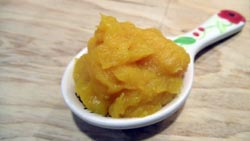The menus for baby food below are designed to give you an idea of what babies may be eating from 4 months to 8 months of age.
Do NOT feel as though your baby should be eating solid foods according to any schedule. Your baby will eat as much solid foods as your baby needs – trust your baby cues. Start out slowly and let baby take time to taste and experiment with the food.
Pay attention to your baby’s cues. She may want more if she continues to lean in for the spoon, opens her mouth or tries to grab the spoon and bring it to her. She may be finished when she turns her head away, clamps her mouth shut or cries as the spoon comes close to her. Don’t fret if there’s leftover food in the bowl and never force your baby to eat “one more bite” when she indicates she’s finished.
This menu sample is for example and idea purposes only! You should always feed your baby according to his or her needs and cues and not strictly by any chart or schedule. You should look to charts and schedules as examples and for ideas about feeding your baby; following any chart or offered schedule may not be suitable for your baby’s particular circumstances and needs.
What is a Food Cube serving? When you see a reference to to a “food cube”, this means an ice cube sized serving. Each cube is equal to approximately 1 ounce.
![]() 4-6 month old babies will likely be eating between 2 and 4 ounces of food per day. Some 4-6 month old babies may not have started solids at all.
4-6 month old babies will likely be eating between 2 and 4 ounces of food per day. Some 4-6 month old babies may not have started solids at all.
At 6 or 7 months old, some infants may eat 4-6 ounces of food per day while babies who are just starting solids at 6 or 7 months of age may be eating only 1-2 ounces per day.
Remember the 4 day wait rule when creating a menu plan for your baby and offer only those foods that your baby tolerates well.
Following any chart or offered schedule may not be suitable for your baby. It is important to say again that this menu sample is for example and idea purposes. The menus are geared to give you ideas of what types of food you could serve at different meal times to get a good balance of nutrients and variety. These menu suggestions assume that you have introduced the foods that are shown and that you have waited the proper time period to detect an allergic reaction. Do NOT feel as though your baby should be eating solid foods according to any schedule. Your baby will eat as much solid foods as your baby needs – trust your baby’s cues.
![]() Breast Milk and/or Formula are THE MOST IMPORTANT sources of nutrition for your infant up to 12 months old. Do NOT replace a nursing or bottle-feeding with a solid food meal and do not feed the solids first until your pediatrician indicates this is right for your baby.
Breast Milk and/or Formula are THE MOST IMPORTANT sources of nutrition for your infant up to 12 months old. Do NOT replace a nursing or bottle-feeding with a solid food meal and do not feed the solids first until your pediatrician indicates this is right for your baby.
![]() When you look at these sample menus, don’t think about serving adult sized portions. Your little one surely could not eat 1 cup of oatmeal with 1 whole avocado mashed into it. However, your little one might be able to eat 4 tablespoons of oatmeal with 2 tablespoons of mashed avocado. We do not note amounts of foods because, as we say, all babies are different and will be eating differing amounts of foods.
When you look at these sample menus, don’t think about serving adult sized portions. Your little one surely could not eat 1 cup of oatmeal with 1 whole avocado mashed into it. However, your little one might be able to eat 4 tablespoons of oatmeal with 2 tablespoons of mashed avocado. We do not note amounts of foods because, as we say, all babies are different and will be eating differing amounts of foods.
By 8-9 months of age, most babies will be eating 3 solid food meals per day. A baby’s appetite will change from one meal to the next so don’t expect your baby to eat 3 “full” meals each and every day.
Read our How Much Should My Baby Be Eating article to learn why your baby may eat more or less than others. All babies are different and your baby may eat more or less than what is shown on these example charts.
Remember, it cannot be stressed enough; all babies are different and your baby may eat more or less than what is shown on these example charts. This menu and sample schedule outlines examples and shows ideas for solid foods only. It does not account for, nor does it list, total daily Breast Milk or Formula intake. See a “Suggested “Milk” chart on the right sidebar to view how much “milk” your baby should be/might be drinking.
As always, you should feed your baby according to his or her cues and needs. Always consult your pediatrician if you are worried that your baby is not receiving proper amounts of either milk or solid foods.
Many breastfeeding moms supplement with formula as their milk supply may be low for a variety of reasons. We give kudos to those moms who continue to hang in there and offer their babies breast milk while supplementing. Hooray for you. You will find our menu samples include the use of both breast milk and formula, separately and together as a total “meal” solution.
![]() Remember, always consult with your pediatrician regarding introducing solid foods to your baby and specifically discuss any foods that may pose allergy risks for your baby.
Remember, always consult with your pediatrician regarding introducing solid foods to your baby and specifically discuss any foods that may pose allergy risks for your baby.
Suggested Daily “Milk” Intakes for Babies age 0 to 12 months
- 0-3 Months of age:
Breastfeed every 1-3 hours or Formula 18-40 ounces - 4-5 Months of age:
Breastfeed every 2-4 hours or Formula 24-45 ounces - 6-8 Months of age:
Breastfeed every 3-4 hours or Formula 24-37 ounces - 9-12 Months of age:
Breastfeed every 4-5 hours or Formula 24-31 ounces
Whole Cow Milk, as a drink, should not be introduced until 12 months of age. Learn about Introducing Yogurt and Feeding Cheese to your baby.
Table compiled from Merck Source





